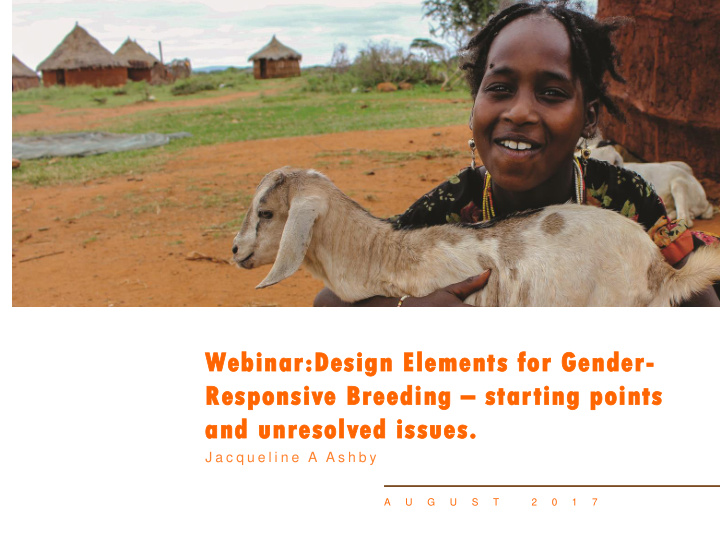



Webinar:Design Elements for Gender- Responsive Breeding – starting points and unresolved issues. J a c q u e l i n e A A s h b y A U G U S T 2 0 1 7
Topics • Where are we coming from? Summarize conclusions from the Gender, Breeding and Genomics workshop held in Nairobi, Kenya in 2016 • Unresolved issues? Examine the evidence gap on gender differentiated trait preferences: why it exists and what needs to be done about it?
“Must - have” features of gender -responsive pla lant t or or anim imal l breed edin ing
Conclusion: What’s missing? Capacity for strategic assessment of (1) “Who are we breeding for?” and (2) “What is the economically, culturally and socially important demand for gender- differentiated traits and products that breeders can realistically develop?”
Review of f evidence on gender dif ifferences in in tr trait preferences • Documentation of gender differences in trait preferences • Methods used • Patterns in gender-differentiated trait preferences (GDTPs) Literature search: ‘gender’, ‘farmer’, ‘woman’ ‘traits’, ‘plant breeding’, ‘preference’, ‘seed’, ‘selection’ 1985-2016, Web of Science, EVFA, SOWIPORT, JSTORE, CAB, PRGA cases, dissertations. Of 300 studies reviewed, 39 explained rationale for GDTPs
Big Gaps Deficit of evidence on gender-differentiated preferences relevant to breeding in • Studies of agricultural marketing and demand • Women‘s crops • Roots, tubers and bananas • West Asia and North Africa • Most studies of traits preferences are one-off and not designed to provide broad geographical coverage or extrapolate generalizable conclusions to a well-defined population • The vast majority of 300 studies reviewed did not investigate causal relationships between trait preferences and gender roles or norms gender.cgiar.org
Findings: Some trait preferences are unique to women or men Identified only by women Identified only by men • Vigour • Tall height for ease of harvest • Resistance to water logging • Adapted to diverse growing conditions • Adapted to intercropping • Leafiness • Yield/ha • Storage life • Suitability for local dish • Ease of dehulling • Quantity of useable flour • Fuel quantity from stover • Cooking time • Taste • Grain colour Source: E. Weltzien, A. Christinck, F. Rattunde, J. Ashby gender.cgiar.org
Findings: gender differences are not clear- cut --Some trait preferences are shared but more important to women Production traits more important to women: • Earliness • Ease of harvesting, and transport • Grain traits • Pest and disease resistance • Multiple, successive harvests • Requirements for weeding Other post-harvest and food processing traits E. Weltzien, A. Christinck, F. Rattunde, J. Ashby gender.cgiar.org
Patterns Men and women • Farm same crop under similar conditions – trait preferences tend to be similar. • Farm same crop under different conditions • Farm same crop with different objectives • Farm different crops (“women’s crops vs. men’s) - trait preferences tend to diverge. ****Preferences and patterns are not static
What’s missing? Capacity for strategic assessment of (1) “Who are we breeding for?” and (2) “What is the economically, culturally and socially important demand for gender-differentiated traits and products that breeders can realistically develop?”
1. Who are we breeding for? Who is the priority CGIAR target beneficiary (end user) Targeting for the breeding Consumers program ? Targeting Poor consumers Non-poor consumers producers Men Men Women Women Non-poor producers Breeding to improve Not CGIAR Mission Men low-cost staples Women (classic green revolution) Poor producers Breeding to improve ? Unique female trait Men competitiveness in Women high-value, export or preferences boutique markets Trait prioritization is not allied to well-defined targeting of the intended beneficiary group and their trait preference(s): generalizable at scale!
2 . . What‘s the (gendered) trait most in demand? Breeders’ question: what’s the feasible, high priority gendered trait with potential for economic impact at large scale? Gender Trade-offs among traits requires Norms analysis of causal relationships Male trait (rules) preferences between gender norms and trait Male roles preferences to identify if gender In production matters to demand. Shared trait preferences Women can adopt Female roles under current Adaptive trait in production preference conditions Female trait preferences Different Women producers Strategic trait Production can adopt with preference Constraints added transformative intervention(s)
Next Steps : better targeting and trait prioritization Progress towards gender- responsive breeding programs requires an improved evidence base • with comprehensive geographical coverage • representation of well- identified target populations • profiles of the gendered trait preferences associated with different gender roles and constraints
Challenge – next workshop What kind of research is needed from social scientists and breeders to target well-defined beneficiary group(s) at scale and identify where, how and for whom gender matters in the demand for improved crops or animal breeds?
Donec eget ligula tincidunt, commodo nisl vel, facilisis erat. Duis bibendum nulla eu velit venenatis mollis. Vivamus scelerisque lobortis facilisis. Aenean magna neque, commodo et nisi at, congue blandit nunc. Aenean elementum sapien magna, a fermentum dui pulvinar nec. Donec eget ligula tincidunt, commodo nisl vel, facilisis erat. Duis bibendum nulla eu velit venenatis mollis.
Recommend
More recommend